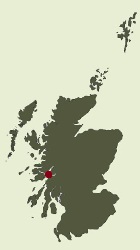 Lismore
Lismore
Lismore is a big garden, I kid you not. Lios-mór - big garden. It is one of Scotland's most fertile islands and it has something to offer for virtually anyone. Less than 200 years ago, around 1,500 people enjoyed the fruits of this beautiful garden, but now the island supports less than 150 residents, along with its daily amount of visitors.
So here is why you should visit Lismore.
The scenery.
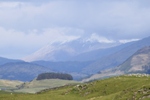 Its position in Loch Linnhe gives it fines views all around. Starting towards the northeast and then clockwise: Ben Nevis, the Glencoe hills, Ben Cruachan, Mull and finally Morvern. All in a day's walk. Depending on the weather of course.
Its position in Loch Linnhe gives it fines views all around. Starting towards the northeast and then clockwise: Ben Nevis, the Glencoe hills, Ben Cruachan, Mull and finally Morvern. All in a day's walk. Depending on the weather of course.
The finest views are - or so we read - from the highest point of the island: Barr Mór, a wopping 127 m. That is the southern half of the island. 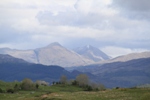 However, we walked the northern half, from Point to Achnacroish and then via the west side back to Point.
A fine walk of some 15 km/9 miles.
However, we walked the northern half, from Point to Achnacroish and then via the west side back to Point.
A fine walk of some 15 km/9 miles.
It took a wee while, but Scotland's big giant finally sort of revealed itself in the afternoon. The Glencoe hills were pleasant companions for most of the walk along the island. Ben Cruachan was still covered in snow (3 June 2015). 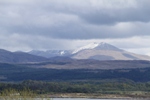
Wherever you look, there is something wee or grand to see: the sun throwing pearls over Loch Linnhe, Eilean Dubh - the wee island between Lismore and the mainland - trees growing through ruined cottages, thin birch trees having a cèilidh... Take a camera with you and you'll fill a memory card. Nature has a field day in the big garden. Really truly.
 Lismore also has its share of history, which is hardly suprising considering it is such a fertile place. Tirfuir broch is a fine example of ancient history, but you can find more information on this nice construction on my page of brochs.
Lismore also has its share of history, which is hardly suprising considering it is such a fertile place. Tirfuir broch is a fine example of ancient history, but you can find more information on this nice construction on my page of brochs.
Moving some 500 years further, we end up with Saint Moluag, the Irish saint who brought Christianity to the island. He is a contemporary of Saint Columba - aye, the more famous one once residing on Iona - and like his fellow Irishman, he founded a monastery on the island. He died 25 June 592 and he is still celebrated annually. And what is even more interesting is the fact that Saint Moluag's original staff - the bachuil - still exists and has been held by the same family for centuries. The Livingstones even have the charter to prove it: a Latin document dating back to 1544, confirming them as hereditary keepers of the lands of Bachuil of Lismore where the staff is held. You can even make an appointment with the Baron of Bachuil to view the staff. Now how's that for a precious relic?
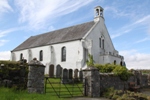 That's not all as far as religion is concerned. Once upon a time around 1200, Argyll - the area Lismore belonged to - became its own diocese. A diocese needs its own cathedral. And guess where that cathedral stood? Right you are: on Lismore. Unfortunately there is no cathedral anymore, but the parish church contains elements of the original construction.
That's not all as far as religion is concerned. Once upon a time around 1200, Argyll - the area Lismore belonged to - became its own diocese. A diocese needs its own cathedral. And guess where that cathedral stood? Right you are: on Lismore. Unfortunately there is no cathedral anymore, but the parish church contains elements of the original construction.
You may ask how Lismore came to be the ecclesiastical centre of Argyll. That had a lot to do with the MacDougalls, the clan who pretty much dominated the western Highlands during their heyday. Lismore was part of the area they controlled.  This resulted not only in them managing to bring the cathedral of the Isles within their boundaries and even installing their own choice of men within the church, but also demonstrates itself in two fortifications on the island: Achadun Castle and Castle Coeffin. The MacDougalls had a string of state-of-the-art fortresses all over the western isles. Achadun Castle is on the southern half of Lismore, so we did not visit that one. It was built around 1292 and was held by the Bishops of the Isles later.
This resulted not only in them managing to bring the cathedral of the Isles within their boundaries and even installing their own choice of men within the church, but also demonstrates itself in two fortifications on the island: Achadun Castle and Castle Coeffin. The MacDougalls had a string of state-of-the-art fortresses all over the western isles. Achadun Castle is on the southern half of Lismore, so we did not visit that one. It was built around 1292 and was held by the Bishops of the Isles later.
Castle Coeffin is a 13th-century building
on the north-west coast of the island. It is completely ruined but still has its charm... and when we visited it, it also had a couple of very stubborn tourists who insisted on having their tea smack in the middle of the photographic centre. 
The MacDougalls did not retain power. They had the misfortune to back the wrong side when Robert the Bruce vied for the throne and ended up losing most of their possessions to their kinsman the MacDonalds and - abooboo - newcomers, the Campbells.
What else?
One of the greatest treasures of the early Gaelic collection in the National Library of Scotland originated on Lismore: "The Book of the Dean of Lismore" -
a volume containing mostly Gaelic poetry. Important note: one of its main scribes is a MacGregor: James MacGregor (died 1551), titular Dean of the cathedral church of Lismore.
Lismore is also reputed to have two illicit whisky distilleries. (We didn't find them.)
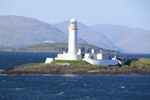 A description of Lismore is not complete without mentioning the Lismore Lighthouse. It was one of the several lighthouses constructed by Alan Stevenson and it is situated on the most southern isle of Lismore: Eilean Musdile. Back in 1833 people operated the lighthouse but since 1965 it is fully automated. The white tower is a fine view when travelling by boat from Oban to Mull (and back).
A description of Lismore is not complete without mentioning the Lismore Lighthouse. It was one of the several lighthouses constructed by Alan Stevenson and it is situated on the most southern isle of Lismore: Eilean Musdile. Back in 1833 people operated the lighthouse but since 1965 it is fully automated. The white tower is a fine view when travelling by boat from Oban to Mull (and back).
Not enough reasons to visit Lismore? So how's this final one? There is a funny breed of finches on the island. I have heard various dialects and end tunes of Scottish finches, but nowhere else have I heard them singing it donkey style. What is that all about?
So how do you get there? Two options. An hour-long ferry will take you from Oban to Achnacroish, smack in the middle of the island, which leaves you the choice to tackle either side. A small passenger ferry from Point Appin carries you in less than ten minutes to Point, the northern tip of Lismore. A lot shorter, plus you have the advantage of reading safety instructions reminding passengers not to use the lift... on a small boat carrying a dozen passengers at most.
More information is available on this site.
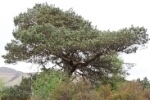 Home
Home
